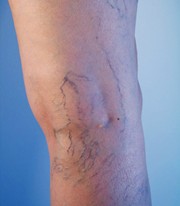Pregnancy: Varicose Veins
Causes And Treatment For Pregnant Women
![]()
![]()
Pregnancy: Varicose Veins |
 |
Pregnancy: Varicose VeinsContents • What Are Varicose Veins? |
|
What Are Varicose Veins?
Varicose veins are enlarged twisted or swollen veins. They tend to appear near the surface of the skin, looking blue or purple and slightly bulged. Most commonly they appear on the legs, inner calves or ankles. During pregnancy, they can also appear on the tummy as well as in vulva/labia and groin area; and can be painful. In fact pregnancy induced hemorrhoids or piles are just varicose veins which appear in the rectal area. One in four Americans suffers the pain of varicose veins at some point in their life, but women are twice as likely to suffer as men. Pregnancy in particular seems to promote the development of veins in women, particularly in the legs and vulva. This may be due to the increased levels of pregnancy hormones (including progesterone) and restricted blood flow from the leg veins to the pelvis by an enlarged uterus. Varicose veins tend to become more prominent during the second trimester.
Most women find the appearance of varicose veins the worst symptom as they can appear quite unsightly. Additionally, many report a pain or throb, combined with a burning itching feeling, particularly at the end of the day. In more severe forms, the legs may develop a brow-gray tinge, combined with scaling, especially around the ankle area. Increased blood pressure can in some instances also result in skin ulcers. In rare cases, complications occur such as inflammation of the veins, a condition known as Phlebitis, or blood clots (Thrombophlebitis). Deep Venous Thrombosis (DVT) is also a rare risk, a condition where clots develop in deep veins. Pregnant women are more susceptible to DVT, even if varicose veins do not develop. Varicose veins occur when the valves inside the veins start to malfunction. The veins are thin walled vessels which carry blood around the body. From time to time, the valves inside the veins, which control the flow of blood become weakened, the blood starts to pool up behind the valve. This causes the vein to become enlarged and distorted. Varicosities can be seen through the skin as blue or purple raised bulges. Sometimes they are accompanied by spider veins (Telangiectases), a common and mild form of varicose veins. Spider veins are hair thin, and usually occur around the ankles. See also stretch marks, another common skin complaint.
Women tend to diagnosis the condition themselves - the appearance of bulging veins on the skin is easy to see. A doctor can more accurately diagnose by feeling the legs and looking for swelling when the woman is standing. If you find that when lying down, raising the legs above chest (heart) level relieves leg pain, then there is a good chance that the problem is varicose veins. An even more accurate diagnosis can be gained through a Doppler ultrasound which can measure blood flow through veins. Also a Venography may be suggested, which measures blood flow through the veins after they have been injected with a contrast dye. To more about what to expect in your three trimesters, take a quick look at our pregnancy guide. Milder Forms Varicose What Are The Costs Of Surgery? If you are worried about unsightly looking legs after pregnancy, you may wish to consider surgical removal of varicose or spider veins. The costs of surgery (e.g. Sclerotherapy) range between $350 - $650 per leg. If you choose to have surgery for cosmetic reasons, the costs are not likely to be covered by your medical insurance. However, if the surgery is recommended by a doctor for medical reasons, such as intense pain, swelling, ulcers or clots, your medical insurance should cover the surgery - even Medicare provides this cover. As pregnancy and excessive weight gain are important risk factors in causing varicose veins in women, it makes sense to take the following precautions: • Exercise Daily: A 20 minute walk around the block will help blood circulation.
|
| Related Articles on PREGNANCY VARICOSE VEINS
For more advice on treating medical conditions while pregnant, see the following: • Constipation in pregnancy: Causes and treatment. Return to Homepage: Womens Health Advice |
|
WOMENS HEALTH ADVICE: ABOUT PREGNANCY SYMPTOMS |